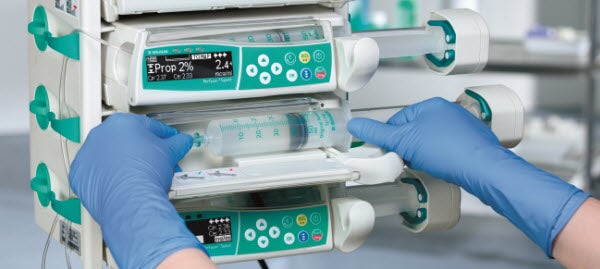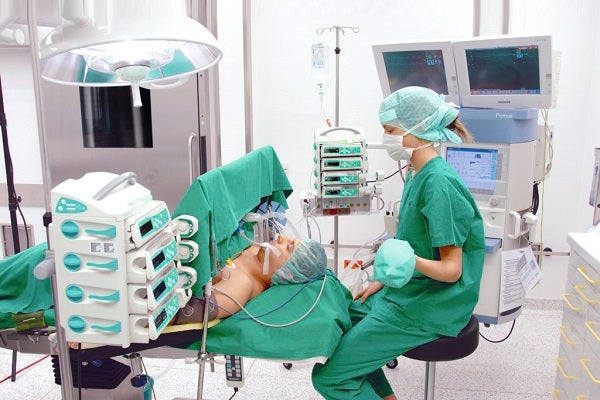Infusion therapy with fluid and volume replacement solutions
Total intravenous anesthesia (TIVA) is a technique of general anesthesia which uses a combination of agents given via syringe pump exclusively by the intravenous route without the use of inhalation agents (Gas Anesthesia).1
There is a solid rationale for the use of TIVA in some patient cases where the delivery of inhaled anesthetics is impossible or disadvantageous, or in scenarios where traditional anesthetic delivery systems may be unavailable or impractical. In other cases, the use of TIVA could make the process more efficient and advantageous for the patient.
Additionally to TIVA, Target Controlled Infusion (TCI)2 is an algorithm based user-friendly technique for the caregiver.
In comparison to traditional inhalation anesthesia, the inherent benefits of TIVA via a Target Controlled Infusion (TCI) are as follows:
TIVA

TCI

TIVA is a technique of general anesthesia which uses a combination of agents given via syringe pump exclusively by the intravenous route. TIVA is:
- purely an anesthetic technique
- used in cases where post-operative pain management will be required
With Tiva multimodal pain management strategies could be applied such as conducting regional anesthesia prior to the TIVA for post-operative use to improve patient recovery.3
In TCI the user is defining a desired concentration of drug in the human body (target) rather than an infusion rate. The rates necessary to reach and maintain that said concentration are calculated by the syringe pump using an algorithm based on a three-compartment pharmacokinetic model. TCI makes TIVA:
- a more straightforward and
- user-friendly technique for the caregiver
Compared generally to traditional volatile anesthetic techniques, TIVA/TCI offer several potential advantages. These include:
- reduced incidence of post-operative nausea and vomiting4,
- better recovery5,
- greater hemodynamic stability6,
- less bradycardia and shorter hypotensive episodes7 and
- better intubation conditions7.
Prescription
Prescription

TIVA can be conducted either with a single drug or with a combination of drugs. The pharmacological profile (pharmacokinetics) of the drug helps clarify its clinical implications and thus assists in drug selection. The most commonly utilized groups of drugs include hypnotics and short-acting opioids.8 The discovery of Propofol in the 70s revolutionized the use of TIVA. It is currently the only intravenously active hypnotic agent suitable for the induction & maintenance of anesthesia. Propofol-based TIVA techniques offer many advantages including rapid recovery of consciousness and psychomotor function, enhanced recovery speed, anti-emetic effect and a lower incidence of post-operative nausea and vomiting.9 The Propofol can be coupled with opioids, muscle relaxants, NSAIDs etc. depending on the patient case or the type of procedure to be performed.
When using TIVA via TCI, short-acting opioids are preferred. It was seen that TIVA via a TCI allows rapid emergency from anesthesia in elective inpatient surgery.10 Similar results have also been noted in outpatient surgeries.
Predefined therapy schemes save staff time.
To select the right therapy, Space provides a variety of TCI algorithms (Propofol: Schnider, Marsh; Remifentanil: Minto; Sufentanil: Gepts) as well as user profiles (plasma targeting/effect site targeting).
Patient Access
Patient Access

As TIVA is conducted exclusively via an intravenous infusion, the choice must be made from either a peripheral or a central venous access device.
This selection is often guided either by the patient condition, or by the number and types of drugs being infused. For short term procedures, where extended venous access is not considered necessary, an Intravenous Catheter could be used.
For patients where it is expected that post-procedure infusions would be required (for e.g. in critically ill patients), or in patients receiving a regimen of mutually-incompatible drugs, a multi-lumen central venous catheter is recommended.
For neonatal or pediatric patients, a scalp vein set could also be used as an access device.
Preparation
Preparation

The selected drugs may or may not be available in ready-to-use glass/plastic vials, or glass/plastic ampoules. Ready-to-use drugs can be drawn up into syringes directly or through a filter.
For drugs that need mixing, needle-free mixing devices and mixing bags could are recommended.
In some cases, process-specific procedure kits could be applied which include all the necessary devices, drapes and dressings, based on the choice of method or drug combination. These procedure kits could support in making the entire process safer and more efficient.
Application
Application

For the anesthesia conducted either via conventional TIVA or via TCI, a smart syringe pump is used.
TIVA (conventional)
- Via using infusion pumps with integrated drug library including safety limits
- Manual adaption of infusion parameter based on the patient's reaction
- Infusion parameters at a glance
TCI
- Via using infusion pumps with integrated TCI algorithms
- User control with the possibility of delivering manual bolus during TCI
- Visualization of anesthesia via graphical overview
- Ability to change the drug concentration
- Algorithm ensures a light, sufficient and consistent anesthesia
- Choice of algorithms:
Propofol: Schnider, Marsh
Remifentanil: Minto
Sufentanil: Gepts
Discharge Management
Discharge Management

TIVA in itself does not support post-operative pain management, however if used in a multimodal pain management approach such as in combination with regional anesthesia, continued analgesia can be provided. If no regional anesthesia is conducted or if post-operative pain can be managed via the infusion of IV analgesics, the same syringe pump can immediately be switched over to this therapy thus helping to improve patient satisfaction.
There are effective ways to continue the post-operative pain management after discharge from the hospital.
Portable single elastomeric pumps allow the patient to receive the necessary medication, even in the homecare setting.
References
- Total Intravenous Anesthesia using a target controlled infusion – A pocket reference’, College of Anesthesiologists, Academy of Medicine Malaysia (retrieved 07.10.15).
- Campbell, L., Engbers, F. H., & Kenny, G. N. (2001). Total intravenous anaesthesia. CPD ANAESTHESIA, 3(3), 109-119.
- Aunac, S., Carlier, M., Singelyn, F., & De Kock, M. (2002). The analgesic efficacy of bilateral combined superficial and deep cervical plexus block administered before thyroid surgery under general anesthesia. Anesthesia & Analgesia, 95(3), 746-750.
- Ozkose, Z., Ercan, B., Ünal, Y., Yardim, S., Kaymaz, M., Dogulu, F., & Pasaoglu, A. (2001). Inhalation versus total intravenous anesthesia for lumbar disc herniation: comparison of hemodynamic effects, recovery characteristics, and cost. Journal of neurosurgical anesthesiology, 13(4), 296-302.
- Lee W.-K., Kim M.-S., Kang S.-W., Kim S., Lee J.-R. (2015). Type of anaesthesia and patient quality of recovery: a randomized trial comparing propofol–remifentanil total i.v. anaesthesia with desflurane anaesthesia, BJA: British Journal of Anaesthesia, 114(4):663–668.
- Wang Y., Yan M., He J.G., Zhu Y.M., Hu X.S., Li X., Wu W.D. (2011). A randomized comparison of target-controlled infusion of remifentanil and propofol with desflurane and fentanyl for laryngeal surgery, ORL J Otorhinolaryngol Relat Spec., 73(1):47-52.
- Godet G., Watremez Ch., El Kettani C., Soriano Ch., Coriat P. (2001). A Comparison of Sevoflurane, Target-Controlled Infusion Propofol, and Propofol/Isoflurane Anesthesia in Patients Undergoing Carotid Surgery: A Quality of Anesthesia and Recovery Profile, Anesthesia & Analgesia, 93(3):560-565.
- Nora, Fernando Squeff. (2008). Total intravenous anesthesia as a target-controlled infusion: an evolutive analysis. Revista Brasileira de Anestesiologia, 58(2), 179-192. Retrieved October 07, 2015, from http://www.scielo.br/scielo.php?script=sci_arttext&pid=S0034-70942008000200011&lng=en&tlng=en. 10.1590/S0034-70942008000200011.
- Absalom A & Struys M. An Overview of TCI & TIVA. Second Edition., 2011; Gent: Academia Press.
- Hogue, C. W., Bowdle, T. A., O'Leary, C., Duncalf, D., Miguel, R., Pitts, M., ... & Batenhorst, R. (1996). A multicenter evaluation of total intravenous anesthesia with remifentanil and propofol for elective inpatient surgery. Anesthesia & Analgesia, 83(2), 279-285.


